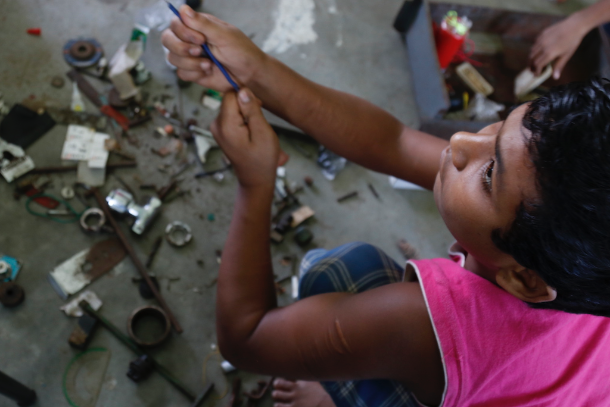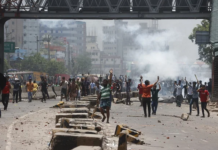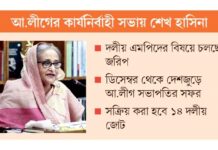
A child at the Apongaon center in Singair, Bangladesh, receives vocational training on June 26. (Photo by Stephan Uttom/ucanews.com)
The sun has started shining again for Muhammad Rafiq after most of his adult life was spent in drug-induced darkness.
The 29-year-old Bangladeshi Muslim has been addicted to marijuana, phensedyl syrup and ya ba (tablets with a mixture of caffeine and methamphetamine produced in Myanmar) for more than a decade.
Like many others, his attraction to drugs was fueled by curiosity. “In my college years, some of my friends were addicts and I was curious about drugs. Marijuana was the first drug, then alcohol and then I approached phensedyl and finally ya ba,” said Rafiq (not his real name), who hails from Jhenaidah district of southwestern Bangladesh.
Rafiq’s family didn’t realize his problem for quite some time, but once they did they took him to Apongaon, a drug rehabilitation center in Singair of Manikganj district in central Bangladesh, in April.
“It was a very difficult time for me without drugs for the first five days. But I have tried very hard to cope with the situation and I feel better now. My health has improved,” he said.
Rafiq undertakes physical exercise, counseling, vocational training, gardening and sports among other activities at the center.
“Apongaon has taught me how to know myself and people around me. It feels like it is my family. When I get cured, I will pursue my dream of serving people after I complete my education. Life is valuable and I cannot let it get spoiled again,” he said.
Drug addiction has taken away many valuable things from Rafiq’s life. “I have lost a good relationship with my family and good friends, and I have lost my loved one. I have become dishonest and told many lies. Now I have realized my misdeeds and I won’t go back to my ugly past anymore.”
Apongaon has 108 men, seven women and 42 children as residential patients in a clustered compound that includes residential hostels, conference rooms, a school for children up to grade five, a vocational trade school, a garden complex and a playground.
Since 1994, about 3,900 addicts have been cured at the facility, which has offered treatment and rehabilitation services to about 200,000 addicts directly and indirectly, according to head of treatment Asaduzzaman Jewel.
The facility spends 30,000 taka (US$353) for each resident a month, but only four or five of them pay that amount, he said.
“People go to various places for treatment and spend a lot of money but don’t get a good result. We believe drug addiction cannot be cured with other drugs but only with love and a comprehensive rehab process,” Jewel, a Muslim and former addict, told ucanews.com.
Missionary’s brainchild
Apongaon began its mission as a halfway house called APON (Ashokti Punorbashon Nibash or addiction rehabilitation residence) in the Muhammadpur area of Dhaka in 1988. It was the brainchild of American Holy Cross missionary Brother Ronald Drahozal.
Born in Cedar Rapids, Iowa, in 1937, he made his first and final religious vows at the Holy Cross congregation as a brother in 1958 and 1961 respectively. After arriving in Bangladesh in 1962, he taught in church-run schools and oversaw candidates for priestly and religious formation.
Brother Drahozal founded Bangladesh Assistance and Rehabilitation Center for Addicts (BARACA) in Dhaka in 1988. He led the organization until 1995 before handing it over to Catholic charity Caritas Bangladesh as a special project.
During his time at BARACA, he also founded APON in Muhammadpur with funding from his family and relatives, and the help of his confrere, Brother Donald Becker. Changing the name to Apongaon in 1994, he switched the center’s location to Manikganj district in 2007 with financial assistance from local and foreign donors.
Brother Drahozal’s pioneering services for drug addicts brought him national and international recognition over the years. The 81-year-old missionary has been in the U.S. since March for medical treatment.
“He picked up addicts from the streets and offered them treatment, rehabilitation, training and employment. His dream was to offer comprehensive treatment and rehabilitation for drug addicts, especially those who are poor and needy,” said Jewel, who worked with the religious man for 18 years.
Without the American missionary and Apongaon, Jewel’s life could have spiraled out of control. “He has given me a new lease of life. My religion [Islam] does not believe in reincarnation, but I believe my coming to Apongaon and my new life are a sort of reincarnation for me,” he said.

American Holy Cross missionary Brother Ronald Drahozal (center) is seen with street children in Dhaka in this undated photo. Brother Drahozal, 81, has led drug addiction treatment and rehabilitation in Bangladesh since 1988. (Photo courtesy of Apongaon)
Drug crackdown
Bangladesh has made global headlines with a Philippines-style deadly anti-drug crackdown.
From May 15 to June 21, about 160 people, mostly alleged drug dealers, were killed in police “crossfire” — a common euphemism for arbitrary police shootouts in Bangladesh, according to media reports. Police also arrested 20,767 people and filed 15,333 cases in connection with drug dealing, ucanews.com reported on June 25.
According to police, 106,436 cases were filed against 132,883 drug dealers in 2017.
The crackdown and killings have irked local and international rights groups, who called on the government to stop arbitrary arrests and shootouts. The killings have apparently stopped, but the government is moving ahead with a tough bill that aims to introduce the death penalty for drug dealers and their patrons.
Rights activists and drug rehabilitation experts say easy access to drugs, an unabated illegal drug trade and lax law enforcement contribute to the endemic drug menace despite Bangladesh not being a drug-producing country like Myanmar and Afghanistan.
According to the state-run Narcotics Department, about 6.6 million Bangladeshis take drugs, but observers believe the figure should be more than 10 million.
“Killing some low-end drug dealers, leaving the big fish and sending addicts to jail where there are few medical facilities will achieve nothing. The government needs to block the pipeline — entry points for drugs, connections of political leaders and law enforcers to the drug trade and toughening the legal system,” Jewel said.
Child addicts
Addiction among street children has become a new dimension to the drug menace in recent years.
Apongaon officials say there are about 450,000 street kids in Bangladesh and about 150,000 are drug addicts who take marijuana, ya ba and dandy, a vapor solution used for fixing and joining rubber and leather items.
Muhammad Arif (not his real name), 11, has been at Apongaon for the past 16 months for treatment. He has been addicted to marijuana since he was seven.
“Some of my friends got me smoking, and then I started taking marijuana. I misbehaved with my parents and two siblings, and one day I stole money from my father’s wallet and fled to Dhaka’s Sadarghat ferry terminal,” Arif told ucanews.com.
For weeks, Arif sold bottles of drinking water to locals and passengers, but one day volunteers from Apongaon spotted him.
“They asked if I wanted to get rid of addiction and have a better life. I came to Apongaon with two friends and never went back,” Arif told ucanews.com.
Despite his initial struggle with adjustment, Arif says life is much better now.
“I have a dream for my life and I would like to become an engineer after completing my education. Apongaon has taught me honesty, openness and strong willpower. I can help myself and prosper in life, and if I have the ability in the future, I will help Apongaon in every possible way,” he said.









